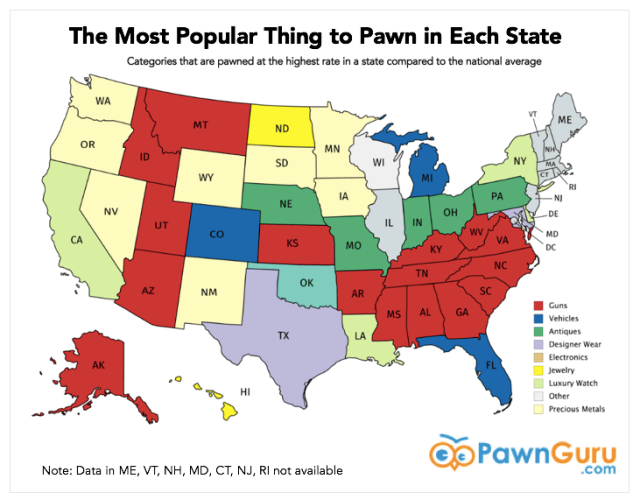
This post is adapted from the blog of PawnGuru, a Priceonomics Data Studio customer. Does your company have interesting data? Become a Priceonomics customer.
***
Anyone can show up to a pawn shop with something valuable and walk out the door with cash. Pawn shops don’t check credit scores since the loans are collateralized, they keep long hours, and are convenient source of cash for 30 million Americans every year.
In the 19th century, Americans have found their lender of last resort by looking for the industry’s “barbershop pole”: 3 dangling golden spheres. Like the rest of retail, that’s changing fast. Widespread smartphone adoption has given working-class Americans access to high speed internet. This sudden digitization lets us answer a question that’s baffled historians and stymied regulators: when Americans need cash, what do they actually pawn?
We decided to analyze pawning data from Priceonomics customer PawnGuru, an national online pawn site. What do people pawn, how much money do they get, and what are the regional differences in pawning behavior.
Across the country, the most popular category of item to pawn is electronics, especially Apple’s smartphones and laptops. However, there are tremendous regional differences. In many Southern and Western states, guns are pawned at a disproportionately high rate, while in California and New York, luxury watches are more popular. As for gender differences, women are most likely to pawn jewelry and apparel. Men on the other hand pawn guns and vehicles.
***
We find significant regional differences in what consumers pawn, as well as differences in what women pawn versus men. These variations tell stories about regional identity, gender, class– and even the power of specific brands, like Apple.
To start our investigation, we looked at nearly a million pawn requests on PawnGuru’s online pawn platform, to assess the most popular categories of items that users submit on our site.
The chart below shows the breakdown of pawn requests by the category of the item:
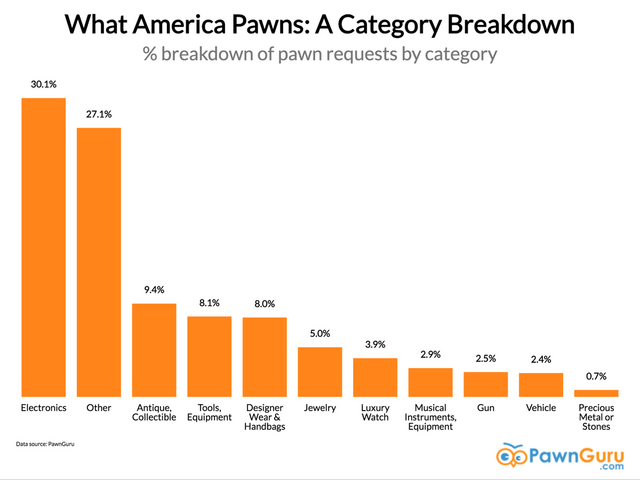
Data source: PawnGuru
The most popular category of merchandise that Americans pawn is Electronics, making up over 30% of requests. With the ubiquity of personal computers, smartphones, gaming consoles, and flat screen televisions, nearly everyone has some type of valuable electronics. After the catchall “Other” category, the most popular categories are Antiques (9.4%) and Tools (8.1%). Jewelry only makes up 5% of requests, and Guns 2.5%. But as we’ll see later, nearly all those gun pawns are concentrated in men in certain parts of the country.
So what are the specific items people pawn, and how much money are people receiving for them? The table below shows the items that people most often pawn and receive an offer on from a pawn shop. These popular items are sorted by price from high to low:
(As a note, the item names are extracted from free-text submissions from the users so this list may not be comprehensive of all items)

Data source: PawnGuru
The most remarkable thing about this chart is the utter dominance of Apple. Among the top 5 most bid on items, 3 are Apple products. Among the top 17 items, 5 are. Apple, it seems, is the apple in a pawn shop’s eye. Apple’s products retain value far longer than its competitors in both personal computing and smartphones. They’re the Honda of electronics– or maybe the Volvo.
From this chart, we can see that the most valuable item people regularly pawn is the diamond ring. This is unsurprising– while diamond rings are reported to have low resale value, the average diamond ring receives an offer of $446. Rings, unlike other pawned goods, have a robust wholesale secondary market. If a pawn shop takes possession of a diamond ring, they’ll usually try to sell it at retail. If they don’t succeed, they’ll sell it to a diamond wholesaler.
In third place, we find guns, with an average offer of $223. It turns out that weapons serve as a remarkably durable store of value. While electronics dominate pawn shop inventories, they depreciate much faster than firearms do. That’s because obsolescence is a much smaller factor in the weapons market. A non-Apple laptop or a smartphone is as good as dead after 5 years. Even an Apple has very little value after a decade. But guns don’t change radically every three years, which means they hold value for a long time.
Electronics are, as the above charts show, a pawn powerhouse across the country. However, we also found tremendous differences across demographics and regions. In particular, we found significant gender differences: women are most likely to pawn jewelry and apparel, while men are prone to pawn guns and vehicles.
To the latter point, we calculated for the given category, what the probability that the person pawning an item is a man versus a woman. The below chart shows each category and percentage of the people pawning an item in that category that are men.
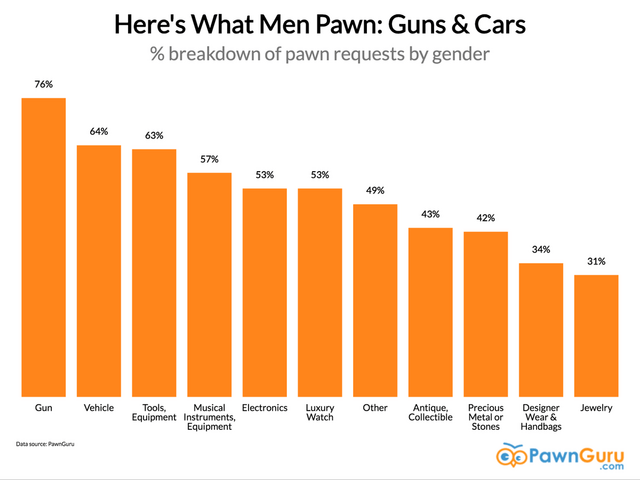
Data source: PawnGuru
By a large margin, the most male-dominated category of pawning is Guns. 76% of people who pawn guns are men, compared to just 31% of the people who pawn jewelry. Males are also most likely to be pawn cars and tools.
And what are women most likely to pawn?
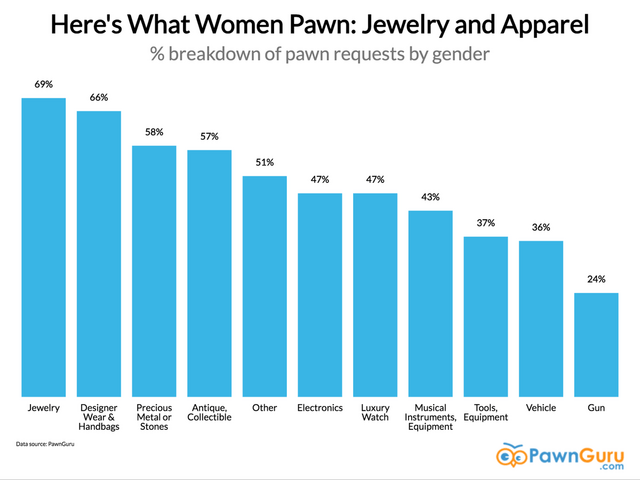
Data source: PawnGuru
If someone is pawning Jewelry, there is a 69% chance they are a woman. Similarly, women have a higher probability than men to pawn Designer Clothes & Handbags, Antiques, and Precious Metals.
How Does Pawning Differ Across States?
Next, we turn our attention geography. Are there any regional patterns in what people pawn across America? For this analysis, we looked at the rate at which people pawn an item of a certain category compared to the national average. For example, if only 2.5% of the pawns across America are guns, but that percentage is 5.0% where you live, guns are “disproportionately popular” there.
The answer is resoundingly yes. In the South and Mountain West, guns are pawned at a disproportionately high rate (almost exclusively by men). In Michigan, cars and trucks are common. In California and New York, luxury watches are more popular. In the Rust Belt, antiques are ubiquitous.
The below map and chart shows what category of pawned items are most “disproportionately popular” in each state.

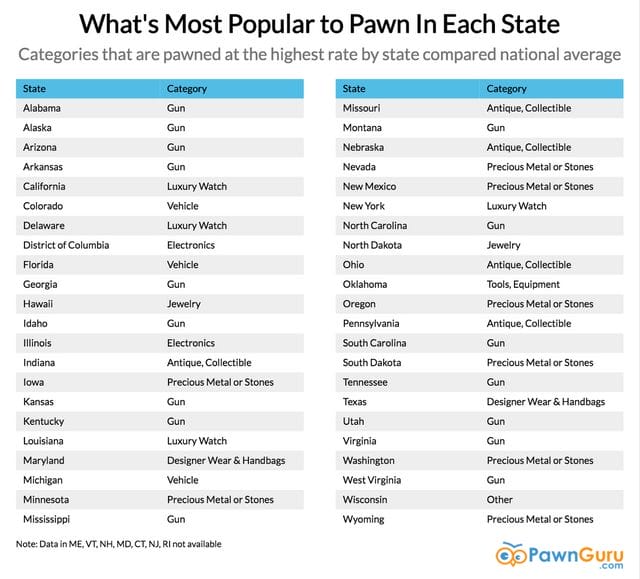
Data source: PawnGuru
Perhaps most notable in the above analysis is the category of guns. In American pawn shops, there are “gun states” and “everything” else states. In Southern states and ones with larger rural populations, like the Mountain West, people pawn guns at a much higher rate than the national average.
Outside of guns, there is much more diversity in the popularity of pawned items by state. Luxury watches are the most disproportionately popular item to pawn in California, New York, Louisiana, and Delaware. Tools are popular in Oklahoma, while Designer Clothes and Handbags over-index in Texas.
Drilling down into the guns category, let’s look at the raw data on what percentage of pawn loans are for guns in each state. Below shows the states with the highest (and lowest) rate of pawning guns:
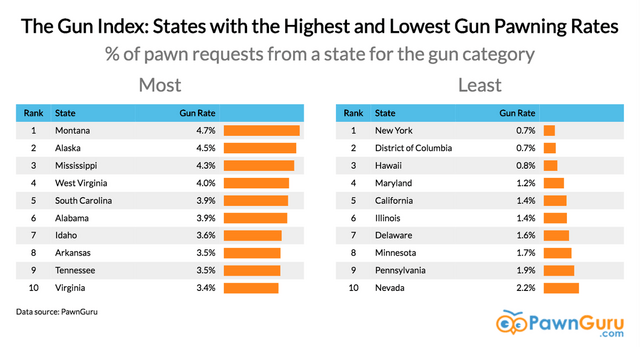
Data source: PawnGuru
Montana, Alaska and Mississippi are the states where the highest percentage of pawns are for guns, each exceeding 4% of requests by our users. On the other hand, in New York, Washington DC and Hawaii, less than 1% of pawn requests are for guns. Someone is almost 7 times more likely to pawn a gun in Montana than in New York state.
Finally, let’s look at data at the city level for some of the most popular markets on PawnGuru. Similar to the state level analysis, the following chart shows the most “disproportionately” popular category of items to pawn by city:
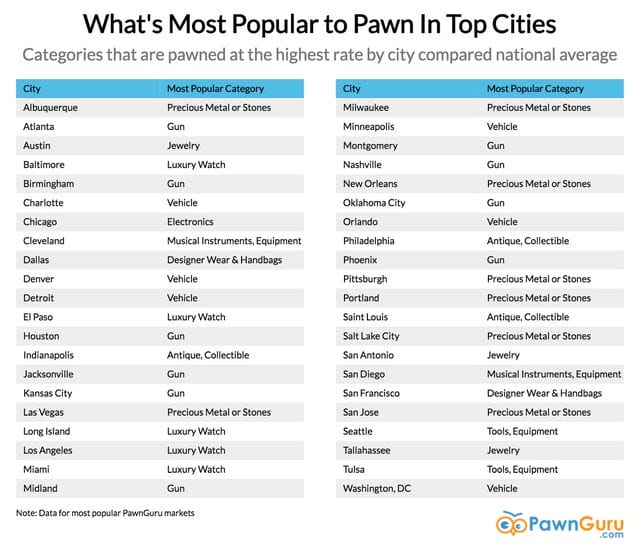
Data source: PawnGuru
Luxury watches are popular in Long Island, Miami and Los Angeles. Designer clothes and bags win out in Dallas and San Francisco. And guns over-index in popularity in a tremendous number of cities; Atlanta, Birmingham, Houston, Jacksonville, Kansas City, Midland, Montgomery, Nashville, Oklahoma City, and Phoenix all count guns as their most disproportionately popular item for pawning.
Just as at the state level, there is a large difference in the rate of pawning guns by city, as the next chart shows:
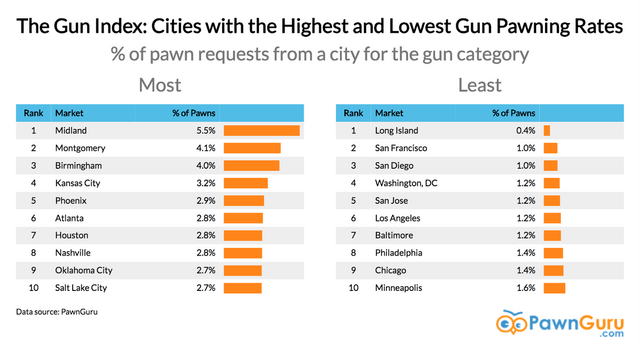
Data source: PawnGuru
Among the largest markets on PawnGuru, Midland has the highest rate of gun pawning in America. A gun is nearly 14 times more likely to be pawned in Midland than Long Island, the market with the lowest rate of gun pawning. Other cities with a 1% rate of gun pawning include San Francisco and San Diego.
***
In summary, we know that across the country, electronics are the most popular type of item to pawn. In that category, Apple commands far higher prices than its rivals in PCs and smartphones. Most people have phones and their resale value make them attractive to pawn shops. When you look at the data by gender, however, divergent patterns emerge among the sexes: men are more likely to pawn guns, cars and tools; women are more likely to pawn jewelry, apparel and precious stones.
But one of the biggest differences in what Americans pawn is guns. While guns are a small overall category for pawnshops, their prevalence varies tremendously by location. Regional difference in attitudes toward gun ownership manifest themselves in a lot of different ways, including at the pawn shop.
***
Note: If you’re a company that wants to work with Priceonomics to turn your data into great stories, learn more about the Priceonomics Data Studio.



